urbanization
Urban Greening Boosts Rodent Population and Zoonotic Disease Risk

Moths Face Urbanization Threats and Decline; Conservationists Call for Protection Similar to Bees

Shark Encounters May Rise as Apex Predators Thrive in Urbanized Coastal Cities in Miami: Study

Microplastics Act As Breeding Ground for Antibiotic-Resistant Bacteria, Study Reveals
Isolated Tiger Snake Populations More Prone to Inbreeding Due to Urbanization; May Lose Ability to Adapt

Anthropogenic Resistance Concept: Human Behavior Affects Wildlife Movement
Climate Change And the Urban Heat Island in California's Central Valley
Most Popular

How Technology Is Changing the Real Estate Industry?

How a Plant-Based Diet Can Protect Against Breast Cancer: Insights from Nutrition Research

Study Reveals High Turnover in Scientific Research Careers: What This Means for Future Scientists

Why It's So Difficult to Lose Weight: The Biological Explanation Behind Obesity





